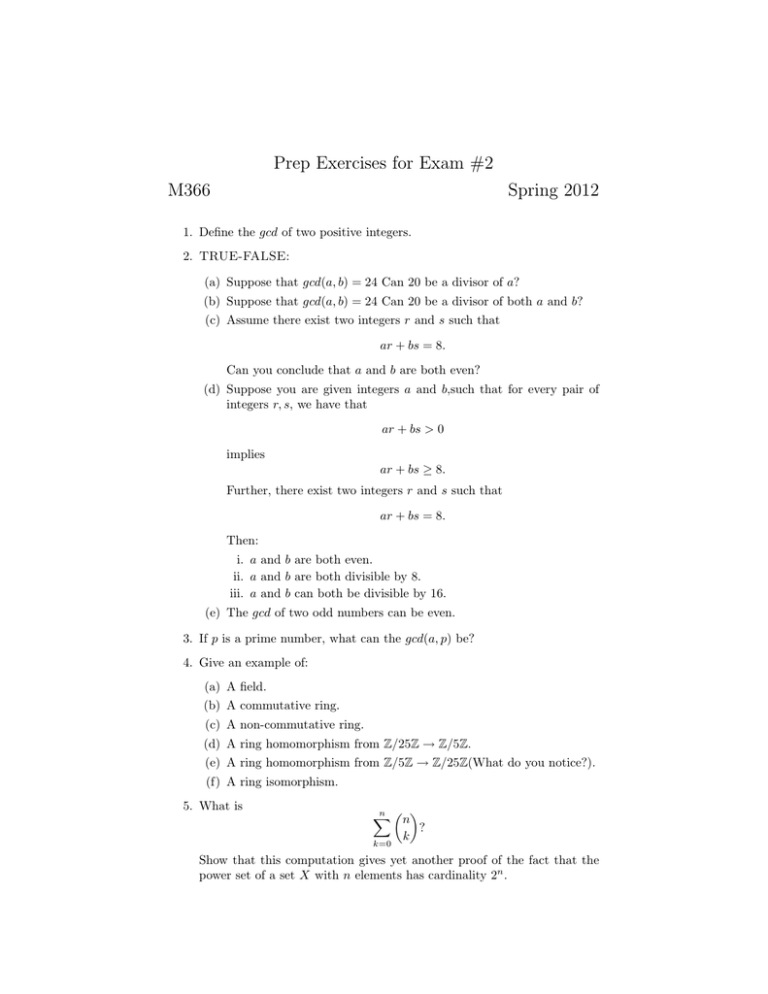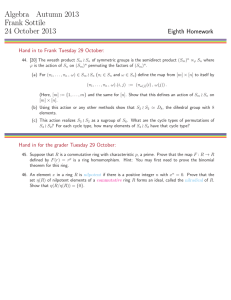Prep Exercises for Exam #2 M366 Spring 2012
advertisement

Prep Exercises for Exam #2
M366
Spring 2012
1. Define the gcd of two positive integers.
2. TRUE-FALSE:
(a) Suppose that gcd(a, b) = 24 Can 20 be a divisor of a?
(b) Suppose that gcd(a, b) = 24 Can 20 be a divisor of both a and b?
(c) Assume there exist two integers r and s such that
ar + bs = 8.
Can you conclude that a and b are both even?
(d) Suppose you are given integers a and b,such that for every pair of
integers r, s, we have that
ar + bs > 0
implies
ar + bs ≥ 8.
Further, there exist two integers r and s such that
ar + bs = 8.
Then:
i. a and b are both even.
ii. a and b are both divisible by 8.
iii. a and b can both be divisible by 16.
(e) The gcd of two odd numbers can be even.
3. If p is a prime number, what can the gcd(a, p) be?
4. Give an example of:
(a) A field.
(b) A commutative ring.
(c) A non-commutative ring.
(d) A ring homomorphism from Z/25Z → Z/5Z.
(e) A ring homomorphism from Z/5Z → Z/25Z(What do you notice?).
(f) A ring isomorphism.
5. What is
n X
n
?
k
k=0
Show that this computation gives yet another proof of the fact that the
power set of a set X with n elements has cardinality 2n .
6. What is
n
X
n
(−1)
?
k
k
k=0
7. What is
X
k1 +k2 +k3 =n
n
?
k1 , k2 , k3
8. Prove that for n ≥ 4
n! ≥ 2n
9. Let XPbe a set with n elements and a1 , . . . , ak be k natural numbers such
that
ai = n. Prove that the number of possible ways of partitioning X
into k subsets A1 , . . . , Ak with |Ai | = ai is
n
n!
:=
a1 !a2 ! . . . ak !
a1 , . . . , ak
10. Prove that R[x] is not a field.
11. Consider the ring Z/12Z. What elements have a multiplicative inverse?
What elements are zero divisors? Can you make a statement for the
general case of Z/nZ? (You may want to do more than one example
before you tackle the general case!)
12. Write the definition of an ideal of a ring.
13. Prove that the set of all numbers that are divisible by 6 is an ideal in
Z. What is the quotient ring isomorphic to? What is the image of the
number 27 under the projection map?
14. Consider the ring R = R[x] and the subset I of polynomials such that
p(0) = 0.
(a) Is I an ideal?
(b) What is the quotient ring R/I isomorphic to?
(c) What element does the polynomial x7 + x5 − 12 correspond to under
this natural isomorphism?
15. Consider the ring R = R[x] and the subset I = {p(x) divisible by (x2 +5)}.
(a) Is I an ideal?
(b) Describe the quotient ring R/I.
(c) What element does the polynomial x3 correspond to under this natural isomorphism?





